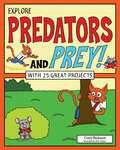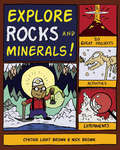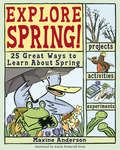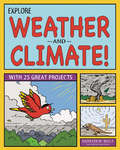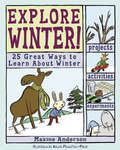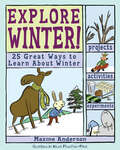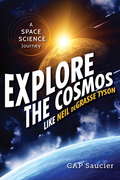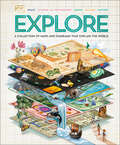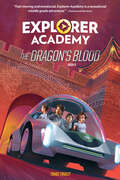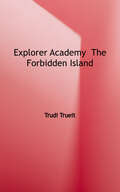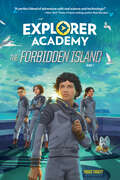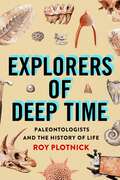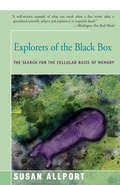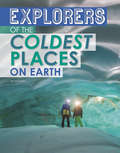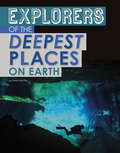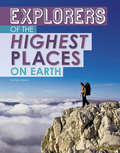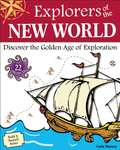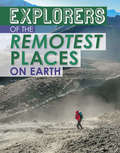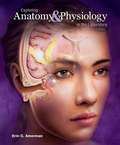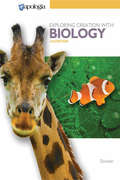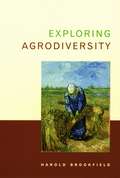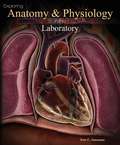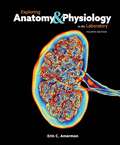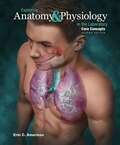- Table View
- List View
Explore Predators and Prey!: With 25 Great Projects
by Cindy Blobaum Matt AucoinHunting, hiding, trapping, and tricking are just a few of the strategies used by animals in the wild to ensure they eat enough without being eaten themselves! In Explore Predators and Prey! With 25 Great Projects, readers ages 7 through 10 explore the physical and behavioral adaptations of predators and prey and their impact on the environment.Predators, such as hawks and foxes, have keen eyesight and sharp beaks and teeth to help them catch their prey. Prey, such as mice and rabbits, have large ears to hear danger and can move quickly to escape their enemies. Animal populations are closely integrated with each other and the surrounding environment. A change to one population causes changes to all others. Readers discover how repercussions can affect nature, including humans, and are encouraged to consider their own actions with an eye toward the effect on the environment.In Explore Predators and Prey, kids actively learn about body tools and behavior strategies as they test their own abilities to hunt and hide in a series of science-minded activities. Fun facts and colorful cartoons make learning entertaining and links to online primary sources and videos make the content accessible to all learners.
Explore Rocks and Minerals!
by Cynthia Light Brown Bryan Stone Nick BrownExplore Rocks and Minerals! offers kids ages 6-9 a fascinating introduction to geology. It investigates the geological forces that create and transform rocks, outlining the life cycle of igneous, sedimentary, and metamorphic rocks, and what they can tell us about the earth. It also explores fossils, and how they come to exist and are discovered.Explore Rocks and Minerals! includes 20 hands-on activities to bring learning to life. Kids create their own crystals, sculpt edible models of the planet, and bake volcanic meringue cookies. These easy-to- follow activities require minimal adult supervision and use common household products. By combining an interactive component with jokes, fun facts, and cartoons, Explore Rocks and Minerals! provides a fun, accessible introduction to geology.
Explore Spring!
by Lauri Berkenkamp Alexis Frederick-FrostFrom tracking spring peepers and raising tadpoles to learning about seeds and recording plant growth, Explore Spring! 25 Great Ways to Learn About Spring invites young readers to explore the wonders of spring by becoming scientists in the field. Combining hands-on learning with solid science, trivia, riddles, and terrific illustrations, projects investigate "the reason for the season" and include identifying trees and measuring their growth, recording soil temperature, and observing the forest floor. Bird migration and nest building are covered, and the movement of air and water is studied with experiments in capillary action and in such activities as "Making Parachutes," Making Kites," and "Mapping Air Currents with Bubbles."
Explore Weather and Climate!
by Bryan Stone Kathleen M ReilleyWhat's it like outside? And what are you going to do about it?Every morning, before heading to school or out to play, kids want to know what the weather is going to be like that day. Is it a day for building a snowman, constructing a sandcastle, or planting a garden? Will they be stuck inside because of rain at recess? Or stuck at home because of snow? And what about tomorrow? Explore Weather and Climate! will help kids understand the "how" and "why" behind the "what." They'll learn how wind, sun, and water combine to form the weather we experience every day. They'll find out why the weather gets extreme. Explore Weather and Climate! offers engaging text reinforced with 25 hands on projects that include creating a storm in a bottle, touching the clouds, and eating an edible climate map, resulting in an unforgettable understanding of these forces of nature.
Explore Winter!
by Maxine Anderson Alexis Frederick-FrostYoung readers become scientists in the field when this activity book sends them off to answer the question "Why do we have winter?" with experiments and projects that mix real science with real fun. Combining hands-on learning with trivia, jokes, riddles, and terrific illustrations, chapters start with the "tools" of science-the scientific method and how to keep a science journal-and then investigate the winter constellations, long nights and long shadows, animal tracking in snow, and food-gathering behavior in birds.
Explore Winter!: 25 Great Ways to Learn About Winter
by Maxine Anderson Alexis Frederick-FrostYoung readers become scientists in the field when Explore Winter! sends them off to answer the question "Why do we have winter?" with experiments and projects that mix real science with real fun. Combining hands-on learning with trivia, jokes, riddles, and terrific illustrations, chapters start with the "tools" of science-the scientific method and how to keep a science journal-and then investigate the winter constellations, long nights and long shadows, animal tracking in snow, and food-gathering behavior in birds.
Explore the Cosmos like Neil deGrasse Tyson
by Cap SaucierThis introduction to space science for children uses the story of Neil deGrasse Tyson's life and career to frame the journey.Catch the thrill of the cosmos and space science through the life of Neil deGrasse Tyson--the popular astrophysicist, science communicator, and host of FOX-TV's Cosmos: A Spacetime Odyssey. In language neither too simple nor overly technical, author CAP Saucier interweaves up-to-date information about the universe and the science of astrophysics with a biographical portrait of the famous astrophysicist. Quotes from Tyson appear throughout each chapter, personalizing the science. Illustrated with striking images from the Hubble Space Telescope, the story of one man's successful life in space science may inspire kids to follow a similar path. As Tyson makes clear, there is still much to do for future space scientists: diverting asteroids, unraveling the mystery of dark matter, finding life elsewhere in the universe, and more!From the Trade Paperback edition.
Explore the Cosmos like Neil deGrasse Tyson
by Cap SaucierThis introduction to space science for children uses the story of Neil deGrasse Tyson's life and career to frame the journey.Catch the thrill of the cosmos and space science through the life of Neil deGrasse Tyson--the popular astrophysicist, science communicator, and host of FOX-TV's Cosmos: A Spacetime Odyssey. In language neither too simple nor overly technical, author CAP Saucier interweaves up-to-date information about the universe and the science of astrophysics with a biographical portrait of the famous astrophysicist. Quotes from Tyson appear throughout each chapter, personalizing the science. Illustrated with striking images from the Hubble Space Telescope, the story of one man's successful life in space science may inspire kids to follow a similar path. As Tyson makes clear, there is still much to do for future space scientists: diverting asteroids, unraveling the mystery of dark matter, finding life elsewhere in the universe, and more!From the Trade Paperback edition.
Explore: A Collection of Maps and Diagrams That Explain the World (Explore)
by DKThis book of maps helps you navigate the big topics that explain the world: science, history, nature, and space.Maps can help you find your way around more than just places, and knowledge can be shared using more than just words. Using maps, children aged 7-9 will be introduced to need-to-know topics in an inviting and visual way.Explore is a new and exciting style of reference that’s packed with diagrams and information to explain each map to inquisitive children. Inside, you’ll find a whole collection of maps to pore over on subjects you’d never expect, from cells and our planet to amphibians and microscopic life.This all-encompassing maps book for children offers: An all-new visual approach to learning core subjects, as part of a brand new exciting reference series.A combination of maps and other diagrams that break down important topics, combined with stats, facts, figures, and explanations.Bright and stand-out illustrations from the award-winning Studio Muti that explore each topic.Follow the routes of animals as they embark on migrations and of seeds as they leave their parent plants. Discover maps to guide you around hidden spaces, like the inside of a beehive, and places as distant as the outer reaches of the solar system. Explore the depths of the ocean, a single cell, a car engine, the human brain, a medieval castle, and much more. This unique book features an encyclopedic range of subjects for children who want to find out everything there is to know about the world.
Explorer Academy: The Dragon's Blood (Explorer Academy)
by Trudi TrueitAn explosive revelation and a familiar face in the sixth book in this adventure-packed series. Still reeling from the life-changing discovery he found buried in the mysterious archive, Cruz Coronado grapples with an important secret as the gang heads to China in search of the second-to-last piece of the cipher. Under the watchful eye of a new adviser, life on the ship returns to almost normal...Almost. Just as things seem to be going smoothly, a familiar face shocks Cruz back into reality, and the final piece in this life-and-death scavenger hunt veers toward a dead end. Explorer Academy features: Gripping fact-based fiction plot that inspires curiosity with new technology and innovations; Amazing inventions and gadgets; A cast of diverse, relatable characters; Secret clues, codes, and ciphers to track down within the text; Vibrant illustrations, Elements of STEAM; National Geographic explorer profiles in The Truth Behind Section. Complete your collection with: The Nebula Secret (1) The Falcon's Feather (2) The Double Helix (3) The Star Dunes (4) The Tiger's Nest (5) Explorer Academy Code-Breaking Adventure Explorer Academy Ultimate Activity Challenge Explorer Academy Field Journal Explorer Academy Future Tech
Explorer Academy: The Forbidden Island (Explorer Academy Series #7)
by Trudi TrueitAfter a near-death encounter and a disappointing message from his mother, Cruz Coronado feels as though he's running out of time to complete the cipher. Can he outsmart Nebula once and for all? Or has his journey come to a permanent end?
Explorer Academy: The Forbidden Island (Explorer Academy)
by Trudi TrueitA heart-pounding final showdown changes the life of Cruz Coronado forever in the seventh and final book in this thrilling fact-based fiction series. Amid assignments that take the Explorer Academy recruits from the iceberg-filled waters of Antarctica to the bone-dry deserts of Argentina, Cruz Coronado is scrambling to complete the last piece of the cipher. With Nebula agents and the elusive explorer spy still out there, his opportunity to recover his mother's world-changing formula is slipping away. But as Cruz has learned from his time aboard Orion, true explorers must never give up. Even after completing dozens of high-risk missions and traveling to all seven continents, Cruz could never prepare himself for one ultimate surprise. Explorer Academy features: Gripping fact-based fiction plot that inspires curiosity with new technology and innovations; amazing inventions and gadgets; a cast of diverse, relatable characters; secret clues, codes, and ciphers to track down within the text; vibrant illustrations; elements of STEAM; National Geographic explorer profiles in the "Truth Behind" section. Complete your collection with: The Nebula Secret (1) The Falcon's Feather (2) The Double Helix (3) The Star Dunes (4) The Tiger's Nest (5) The Dragon's Blood (6) Explorer Academy Codebreaking Activity Adventure Explorer Academy Ultimate Activity Challenge Explorer Academy Field Journal Explorer Academy Future Tech
Explorers of Deep Time: Paleontologists and the History of Life
by Roy PlotnickPaleontology is one of the most visible yet most misunderstood fields of science. Children dream of becoming paleontologists when they grow up. Museum visitors flock to exhibits on dinosaurs and other prehistoric animals. The media reports on fossil discoveries and new clues to mass extinctions. Nonetheless, misconceptions abound: paleontologists are assumed only to be interested in dinosaurs, and they are all too often imagined as bearded white men in battered cowboy hats.Roy Plotnick provides a behind-the-scenes look at paleontology as it exists today in all its complexity. He explores the field’s aims, methods, and possibilities, with an emphasis on the compelling personal stories of the scientists who have made it a career. Paleontologists study the entire history of life on Earth; they do not only use hammers and chisels to unearth fossils but are just as likely to work with cutting-edge computing technology. Plotnick presents the big questions about life’s history that drive paleontological research and shows why knowledge of Earth’s past is essential to understanding present-day environmental crises. He introduces readers to the diverse group of people of all genders, races, and international backgrounds who make up the twenty-first-century paleontology community, foregrounding their perspectives and firsthand narratives. He also frankly discusses the many challenges that face the profession, with key takeaways for aspiring scientists. Candid and comprehensive, Explorers of Deep Time is essential reading for anyone curious about the everyday work of real-life paleontologists.
Explorers of the Black Box: The Search for the Cellular Basis of Memory
by Susan AllportExplorers of the Black Box is a scientific adventure story. The "Black Box" is the brain. The "Explorers" are neuroscientists in search of how nerve cells record memories, and they are as ruthless and dauntless as any soldiers of fortune. The book centers around the early, often-controversial research Nobel Prize-winner Eric Kandel. It takes readers behind the scenes of laboratories at Woods Hole, Columbia, Yale, and Princeton to create an absorbing account of how the brain works and of how science itself works.
Explorers of the Coldest Places on Earth (Extreme Explorers)
by Nel YomtovFor many decades, courageous men and women have ventured to our planet's foreboding icy regions. These brave explorers risk life and limb in the name of science or for the thrill of adventure. Who are these thrill seekers and why do they do it? Turn the pages to find out!
Explorers of the Deepest Places on Earth (Extreme Explorers)
by Peter MavrikisDid you know the deepest parts of the ocean are still largely unexplored? Courageous explorers risk their lives to go to these great ocean depths. Other explorers journey into deep volcanoes, caves, and mines. Who are they and why are they seeking a glimpse of the world deep below the earth's surface? Turn the pages to find out!
Explorers of the Highest Places on Earth (Extreme Explorers)
by Peter MavrikisThe amount of available oxygen at the highest place on Earth is just under 7%. Explorers risk their lives and test their lungs traveling to these great heights atop mountains. Who are these adventurers and why do they do it? Turn the pages to find out!
Explorers of the New World
by Tom Casteel Carla MooneyExplorers of the New World: Discover the Golden Age of Exploration offers a fascinating look at the explorers and their voyages during the Age of Exploration and Discovery. Readers ages 9-12 can delve into the expeditions of Vasco da Gama, Christopher Columbus, Ferdinand Magellan, John Cabot, Hernán Cortés, and more. Using common household items and minimal supervision, kids enjoy 22 hands-on activities to help them learn about these legendary explorers and their voyages. Discover how the adventures of a few people 500 years ago changed world history.Projects include creating and using a compass, learning to tie a sailor's knot, and baking and eating sea biscuits. Along with detailed, step-by-step instructions for each project, Explorers of the New World includes biographical sidebars, engaging illustrations, interesting facts, and vocabulary words that allow kids to experience this era in a fun, interactive way.
Explorers of the Remotest Places on Earth (Extreme Explorers)
by Nel YomtovOf all the places to explore on Earth, remote places are often said to be the most challenging. Yet brave explorers travel to the most remote corners of the world, pushing through vast forests, icy polar regions, and other landscapes. Who are these adventurers and why do they do it? Turn the pages to find out!
Exploring Anatomy & Physiology in the Laboratory (Third Edition)
by Erin C. AmermanThis comprehensive manual is appropriate for a two-semester anatomy and physiology laboratory course. Through focused activities and by eliminating redundant exposition and artwork found in most primary textbooks, this manual complements the lecture material and serves as an efficient and effective tool for learning in the lab.
Exploring Creation with Biology
by Vicki DincherAs scientific studies advance farther out into the universe as well as deeper into the microscopic world, scientists continue to ask, “What is life?” Biology is the study of life, and this 3rd edition of Exploring Creation with Biology teaches not only the science of how we begin to answer the bigger questions defining life, but also includes meaningful discussions on Creation and Creator. <p><p> This updated high school biology course was redesigned to help students see and understand the beauty of life that surrounds us. Full-page infographics were created to help students grasp the concepts discussed in the text and go beyond simple illustrations. <p> As a college-prep high school biology course, it will set the stage for success in homeschooled high school years, prepare students for college level courses, and give them an understanding of the basic biological world that surrounds them each day of their lives so that they can appreciate the real-world relevance of scientific inquiry. <p> Opening with the studies of the process of science, students learn about observations and inferences, hypotheses, experiments, and scientific theories and laws. They are taught to see the limitations of science and learn about the tools used in biological studies. <p> In their studies of life, students will delve into the chemistry of life from atoms to the chemical structures that make life, as we know it, possible. They will explore the ecology that surrounds life as they investigate ecosystems, biomes, populations, and communities. <p> An in-depth study of cell structure and function, cellular energy, DNA, proteins, and cell cycles will help students comprehend heartier materials as they advance to learn about genetics – inheritance, disorders, and technology, as well as the role of genetics in evolution. <p> Students will also learn about prokaryotes, viruses, protists, and fungi. They will delve deep into the fascinating world of plants and animals. And all of their learned knowledge will be backed by hands-on experimentation that takes their book knowledge and applies it to concepts that they can comprehend. <p> At Apologia, we believe that students’ educations should prepare them for life, not just an academic year. This creation-based science course will create the strong foundation students can rely upon as they grow in their awe and wonder of our world. <p> At the completion of this course, students will be able to understand the vocabulary of biology so that they can engage in true scientific discourse. Their strong background in the scientific method regarding experimentation, field studies, microscopy, and dissection will also allow them to be well equipped to analyze data that they will encounter throughout their lifetimes.
Exploring Agrodiversity (Issues, Cases, and Methods in Biodiversity Conservation)
by Harold BrookfieldSmall farmers are often viewed as engaging in wasteful practices that wreak ecological havoc. Exploring Agrodiversity sets the record straight: Small farmers are in fact ingenious and inventive and engage in a diverse range of land-management strategies, many of them resourcefully geared toward conserving resources, especially soil. They have shown considerable resilience in the face of major onslaughts against their way of life by outsiders and government.Using case studies from Africa, Asia, Latin America, and the Pacific, this book provides in-depth analysis of agricultural diversity and explores its history. The book also considers the effect of the "gene revolution" on small farmers and reviews the effects of the "green revolution" in Asian countries. In conclusion, it questions whether the diverse agricultural practices employed by small farmers can survive modern pressures and the global ambitions of the biotechnology industry.
Exploring Anatomy & Physiology in the Laboratory
by Erin C. AmermanMany years ago, when I first started teaching anatomy and physiology, my biggest frustration with the course came from the laboratory. It seemed as if I were pulling teeth to get my students interested in the lab material and most students were unable to make the connections between lecture and lab.
Exploring Anatomy & Physiology in the Laboratory
by Erin C. AmermanExploring Anatomy & Physiology in the Laboratory (EAPL) is one of the best-selling A&P lab manuals on the market. Its unique, straightforward, practical, activity-based approach to the study of anatomy and physiology in the laboratory has proven to be an effective approach for students nationwide. This comprehensive, beautifully illustrated, and affordably priced manual is appropriate for a two-semester anatomy and physiology laboratory course. Through focused activities and by eliminating redundant exposition and artwork found in most primary textbooks, this manual complements the lecture material and serves as an efficient and effective tool for learning in the lab.
Exploring Anatomy & Physiology in the Laboratory Core Concepts
by Erin C. AmermanThis brief version of Exploring Anatomy and Physiology in the Laboratory, 2e, is intended for one-semester anatomy and physiology courses geared toward allied health students. Exploring Anatomy & Physiology Laboratory: Core Concepts, by Erin C. Amerman is a comprehensive, beautifully illustrated, and affordably priced lab manual that features an innovative, interactive approach to engage your students and help ensure a deeper understanding of A&P.
